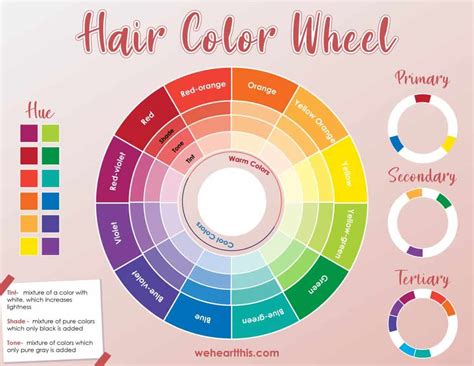Understanding the Hair Color Wheel
The hair color wheel is a visual tool that helps hairstylists and colorists understand the relationships between different hair colors. It organizes shades into a circular spectrum, with primary, secondary, and tertiary colors arranged in a logical sequence.

Primary Colors
The primary colors of the hair color wheel are red, yellow, and blue. These colors can’t be created by mixing any other colors.
Secondary Colors
Secondary colors are created by mixing two primary colors. They include orange (red + yellow), green (yellow + blue), and violet (blue + red).
Tertiary Colors
Tertiary colors are created by mixing a primary color with a secondary color. They include red-orange, yellow-green, blue-green, blue-violet, red-violet, and yellow-orange.
Warm and Cool Colors
Colors on the hair color wheel can be classified as either warm or cool. Warm colors, such as red, orange, and yellow, evoke feelings of warmth and energy. Cool colors, such as blue, green, and violet, evoke feelings of coolness and tranquility.
Neutral Colors
Neutral colors, such as black, white, and gray, do not contain any warm or cool undertones. They can be used to tone down or enhance other colors.
Using the Hair Color Wheel
The hair color wheel can be used to:
- Choose a hair color that will complement your skin tone
- Create harmonious color combinations
- Correct unwanted tones in your hair
- Design creative and eye-catching hairstyles
Choosing a Hair Color for Your Skin Tone
When choosing a hair color, it’s important to consider your skin tone. Warm skin tones look best with warm hair colors, while cool skin tones look best with cool hair colors.
Creating Harmonious Color Combinations
The hair color wheel can be used to create harmonious color combinations. For example, you could pair a warm red with a cool blue-green to create a striking contrast.
Correcting Unwanted Tones
The hair color wheel can also be used to correct unwanted tones in your hair. For example, if your hair has unwanted brassy tones, you could use a purple toner to neutralize them.
Designing Creative Hairstyles
The hair color wheel can be used to design creative and eye-catching hairstyles. For example, you could create an ombre look by blending two or more colors together.
Tips and Tricks for Using the Hair Color Wheel
- Use a color wheel that is specifically designed for hair color.
- Experiment with different colors to find the ones that look best on you.
- Don’t be afraid to mix and match colors to create unique looks.
- Consult with a professional hairstylist if you’re unsure of how to use the hair color wheel.
Step-by-Step Approach to Using the Hair Color Wheel
- Determine your skin tone.
- Choose a color that will complement your skin tone.
- Create a harmonious color combination.
- Correct any unwanted tones in your hair.
- Design your creative hairstyle.
Pros and Cons of Using the Hair Color Wheel
Pros:
- Provides a visual representation of the relationships between different hair colors
- Helps you choose a hair color that will complement your skin tone
- Enables you to create harmonious color combinations
- Allows you to correct unwanted tones in your hair
- Facilitates the design of creative and eye-catching hairstyles
Cons:
- Can be difficult to understand for beginners
- Requires some experimentation to find the best colors for you
- May not be suitable for all hair types
Conclusion
The hair color wheel is a versatile tool that can be used to enhance your hair color and create beautiful, eye-catching hairstyles. By understanding the principles of the hair color wheel, you can experiment with different colors and create a look that is uniquely your own.
Additional Information
The hair color wheel is a valuable tool for hairstylists and colorists. It can be used to:
- Create color formulas
- Correct color mistakes
- Educate clients about color theory
- Develop new color techniques
The hair color wheel is also a great way to learn about the different types of hair colors and how they can be combined to create beautiful, eye-catching hairstyles.
